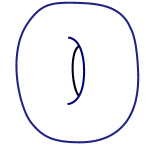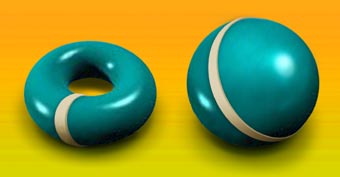Martin Dunwoody, a Professor at the University of Southampton, may have cracked one of the most difficult unsolved problems of mathematics.
The problem is known as the Poincaré Conjecture, after the French scientist Henri Poincaré, who formulated the problem in 1904. Poincaré was working in topology - the study of those properties of mathematical objects that remain unaffected by smooth deformations - when he conjectured that a certain property of the 2-dimensional surface of a sphere also held for higher-dimensional analogues. Though relatively simple to state, the conjecture has proved extraordinarily hard to prove (or disprove!) - the 1982 proof for 4-dimensional "surfaces" won its author the Fields medal - and the remaining 3-dimensional case has resisted all attack for nearly 100 years.
Dunwoody's approach to publicising his work has caused some controversy. He is refusing all interviews, and publishing his proof as a work in progress on the University of Southampton's website (you can check on his progress by going to his department's preprint site). The current posting - version number 8 - is described as an "outline of an attack on the Poincaré conjecture", and thanks five different people for pointing out problems in earlier versions. Dunwoody says at the beginning that there is one problem in particular that he does not see how to rectify, but that he hopes a certain approach will work.

Topologically speaking, a coffee cup and a doughnut are the same
So just what is the conjecture? Well, the 2-dimensional surface of a 3-dimensional sphere - the familiar surface of a ball - is, in topological terms, completely defined by the fact that it is simply connected. In other words, any 2-dimensional surface that is simply connected could be turned into the surface of a sphere just by stretching and distorting - no cutting or tearing would be needed. A surface is said to be simply connected if any closed loop on it can be slid off without cutting. You can see that the surface of a ball is simply connected by imagining a rubber band stretched round it - it can be slipped off smoothly. By contrast, a doughnut is not simply connected - if you cut a rubber band and refastened it around the doughnut as shown above, no amount of sliding would allow you to slip the rubber band off. In essence, Poincaré conjectured that an analogous result held in higher dimensions. Only the 3-dimensional case ("surfaces" of 4-dimensional objects) is still unknown, and this is what Dunwoody is working on.

A doughnut is not the same as a ball
Even if Dunwoody's proof ultimately turns out to be flawed, he will be in august company. Poincaré himself thought he had a proof, and realising his error led him to some important new mathematics. In fact, the history of all the great unsolved problems, and not just the Poincaré Conjecture, is littered with flawed proofs, many of which contain more fine mathematics than correct but pedestrian proofs of less important results.
More than just fame depends on Dunwoody's success - there is also a fortune waiting. The Clay Institute, an organisation dedicated to increasing and disseminating mathematical knowledge, based in Cambridge, Massachusetts, has put up seven $1,000,000 prizes for answers to some of the most important outstanding problems in mathematics - and the Poincaré Conjecture is one of them. Dunwoody must be wishing he could phone a friend or ask the audience...